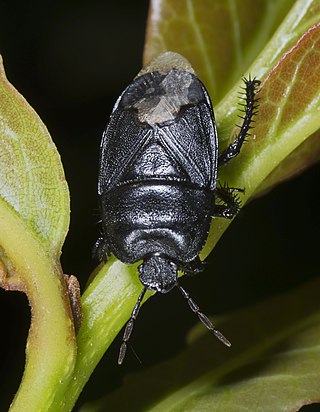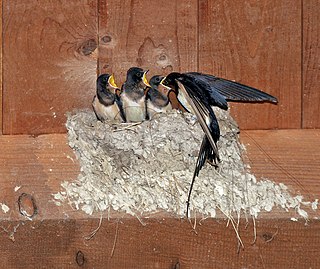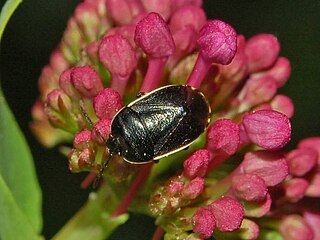
Hemiptera is an order of insects, commonly called true bugs, comprising over 80,000 species within groups such as the cicadas, aphids, planthoppers, leafhoppers, assassin bugs, bed bugs, and shield bugs. They range in size from 1 mm (0.04 in) to around 15 cm (6 in), and share a common arrangement of piercing-sucking mouthparts. The name "true bugs" is often limited to the suborder Heteroptera.

Behavioral ecology, also spelled behavioural ecology, is the study of the evolutionary basis for animal behavior due to ecological pressures. Behavioral ecology emerged from ethology after Niko Tinbergen outlined four questions to address when studying animal behaviors: What are the proximate causes, ontogeny, survival value, and phylogeny of a behavior?

The Pentatomoidea are a superfamily of insects in the suborder Heteroptera of the order Hemiptera. As hemipterans, they possess a common arrangement of sucking mouthparts. The roughly 7000 species under Pentatomoidea are divided into 21 families. Among these are the stink bugs and shield bugs, jewel bugs, giant shield bugs, and burrower bugs.

Brood parasitism is a subclass of parasitism and phenomenon and behavioural pattern of certain animals, brood parasites, that rely on others to raise their young. The strategy appears among birds, insects and fish. The brood parasite manipulates a host, either of the same or of another species, to raise its young as if it were its own, usually using egg mimicry, with eggs that resemble the host's.

Elasmucha grisea, common name parent bug, is a species of shield bugs or stink bugs belonging to the family Acanthosomatidae. The term parent bugs includes also the other species of the genus Elasmucha and some species of the family Acanthosomatidae.
A trophic egg is an egg whose function is not reproduction but nutrition; in essence, the trophic egg serves as food for offspring hatched from viable eggs. In most species that produce them, a trophic egg is usually an unfertilised egg. The production of trophic eggs has been observed in a highly diverse range of species, including fish, amphibians, spiders and insects. The function is not limited to any particular level of parental care, but occurs in some sub-social species of insects, the spider A. ferox, and a few other species like the frogs Leptodactylus fallax and Oophaga, and the catfish Bagrus meridionalis.

Acanthosomatidae is a family of Hemiptera, commonly named "shield bugs" or "stink bugs". Kumar in his 1974 world revision recognized 47 genera; now this number is 55 genera, with about 200 species, and it is one of the least diverse families within Pentatomoidea. The Acanthosomatidae species are found throughout the world, being most abundant in high-latitude temperate regions and in subtropical regions at high altitudes.

Cydnidae are a family of pentatomoid bugs, known by common names including burrowing bugs or burrower bugs. As the common name would suggest, many members of the group live a subterranean lifestyle, burrowing into soil using their head and forelegs, only emerging to mate and then laying their eggs in soil. Other members of the group are not burrowers, and live above the soil layer, often in close association with plants. Several species are known as agricultural pests.

Parental care is a behavioural and evolutionary strategy adopted by some animals, involving a parental investment being made to the evolutionary fitness of offspring. Patterns of parental care are widespread and highly diverse across the animal kingdom. There is great variation in different animal groups in terms of how parents care for offspring, and the amount of resources invested by parents. For example, there may be considerable variation in the amount of care invested by each sex, where females may invest more in some species, males invest more in others, or investment may be shared equally. Numerous hypotheses have been proposed to describe this variation and patterns in parental care that exist between the sexes, as well as among species.

Astatotilapia burtoni is a species of fish in the family Cichlidae.

Gargaphia solani is a subsocial species of lace bug commonly known as the eggplant lace bug. The species was described by Heidemann in 1914 after it aroused attention a year earlier in the United States as an eggplant pest around Norfolk, Virginia. Fink found that the species became an agricultural pest when eggplant is planted on a large scale.

Tessaratomidae is a family of true bugs. It contains about 240 species of large bugs divided into 3 subfamilies and 56 genera.

Sehirus is a genus of burrowing bugs belonging to the family Cydnidae, subfamily Sehirinae.

Sehirinae is a subfamily of burrowing bugs belonging to the family Cydnidae.

Canthophorus is a genus of burrowing bugs in the family Cydnidae. There are about eight described species in Canthophorus.

The Thyreocoridae are a family of shield bugs, known by common names that include negro bugs or ebony bugs. Historically, a few authors have called this family "Corimelaenidae" (e.g.), but the name Thyreocoridae, published in 1843, has nomenclatural priority over Corimelaenidae, published in 1872. Other classifications have placed them as a subfamily within the broad family Cydnidae.
Parastrachia is a genus of true bugs belonging to the family Parastrachiidae. It was established in 1883 by the English entomologist William Lucas Distant. It consists of only two species from Eastern Asia, Parastrachia japonensis and Parastrachia nagaensis. Like some other members of the superfamily Pentatomoidea, they exhibit maternal care of eggs.

Sehirus luctuosus, the Forget-me-not Bug, is a burrowing shieldbug belonging to the family Cydnidae. It is found from Europe to Central Asia.In Central Europe it is widespread and not uncommon. They are found in the Alps on sunny slopes up to almost 2000 meters above sea level.
Vertebrate maternal behavior is a form of parental care that is specifically given to young animals by their mother in order to ensure the survival of the young. Parental care is a form of altruism, which means that the behaviors involved often require a sacrifice that could put their own survival at risk. This encompasses behaviors that aid in the evolutionary success of the offspring and parental investment, which is a measure of expenditure exerted by the parent in an attempt to provide evolutionary benefits to the offspring. Therefore, it is a measure of the benefits versus costs of engaging in the parental behaviors. Behaviors commonly exhibited by the maternal parent include feeding, either by lactating or gathering food, grooming young, and keeping the young warm. Another important aspect of parental care is whether the care is provided to the offspring by each parent in a relatively equal manner, or whether it is provided predominantly or entirely by one parent. There are several species that exhibit biparental care, where behaviors and/or investment in the offspring is divided equally amongst the parents. This parenting strategy is common in birds. However, even in species who exhibit biparental care, the maternal role is essential since the females are responsible for the incubation and/or delivery of the young.

Adomerus is a genus of true bugs belonging to the family Cydnidae.
















